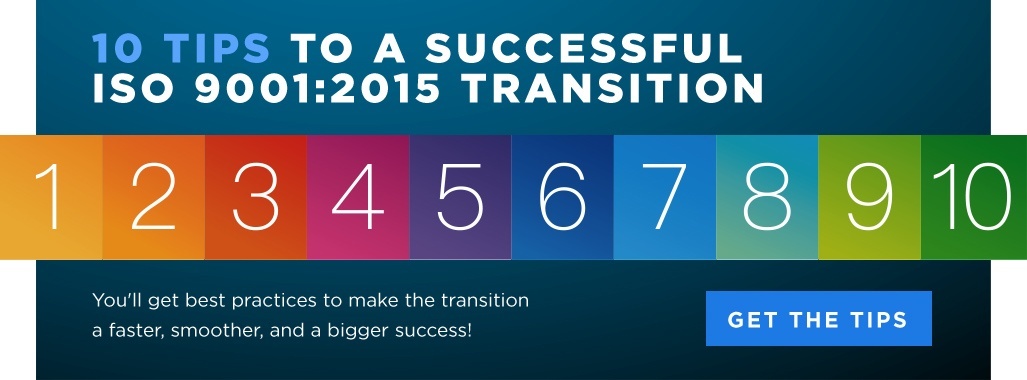A Leader's Light-hearted Reflection on the ISO Transition Journey
Part One: The Story of Our Mad Scramble To Transition to ISO 9001:2015 in 67 Days - part of our series on Project Management Best Practices
Corporate certifications are important notches in any corporate belt, right?
To answer my own question, of course they are.
They provide the proof that product and service suppliers need to convince customers/ clients they are mature in their processes and can consistently meet expectations. Showing that certification to potential or existing customers provides assurance to gain their confidence in product and service delivery, regardless of type, scope, or durational context.
As a new Executive in a Technology company, leading the transition from ISO 9001:2008 to the new 2015 requirement was one of my first challenges to face. Although I was well versed in ISO, CMMI, ITIL, PMO, and other acronyms (certifications...impressive, right?), I was less than a week into my new position when this seemingly monumental task was assigned.
 Our team on day 60 of the ISO 9001:2015 transition...
Our team on day 60 of the ISO 9001:2015 transition...
I had very little knowledge depth across the organization, no opportunity to observe or evaluate processes or operations, and wasn’t even sure I remembered the names of the people on my corporate staff. However, I view myself as a competent, operations-minded professional with a strong background in Program and Project Management (hold the laughter please) so naturally, I did what any PM (i.e., multi-tasking, crisis managing, deadline dictating, team motivating, miracle worker) would do first: I assessed the technical (i.e., requirements) and schedule health of the ISO “Project”.
First, I went to my ISO Document Manager, got her name wrong, and asked for a copy of the new requirements. Spoiler alert; pretty sure she single-handedly saved this project multiple times…see every tip below. She was already on board with the need to get this project started and immediately sent me a “redlined”, 2008-2015 merged copy (Stakeholder buy-in level: Expert…I’m starting off great!).
And then my PM senses went off when I saw A LOT of red in the document; it looked like the first proposal I ever submitted to my management for review. A quick search for Context of the Organization (COTO), Risk, and Interested Party in the existing QMS netted zero results. Got it, this isn’t going to be a “forklift” transition. That’s ok, we have time, right?
Umm…Nope. At that moment, my phone rang and I picked up without recognizing the number. Honestly, I probably wouldn’t have recognized my own number at the time. It was the ISO Auditor! Perfect time for me to discuss a manageable schedule for our transition, right?
Umm…nope! She was calling to confirm our audit date that was now 67 days away and reminded me I am 23 days late in completing my transition application. I didn’t like the way this conversation was headed so in my most professional, soft negotiator voice, I inquired about the re-scheduling procedure. In response, in her most professional, not-laughing voice, the auditor explained that I could potentially re-schedule (YES!).
However, they were booked for the next six months (perfect! I need six months to be ready), we had already paid for the audit this year and we would have to absorb additional audit costs (hmmm), and our 2008 certification would expire in three months leaving us uncertified (I’ll never get that approved).
Like the expert negotiator I claimed to be, I thanked her for her time, informed her she would have the application that day, and expressed how much I was looking forward to meeting her in 67 days! I then proceeded to block off days 67-69 in my calendar for the audit and made a mental note that I was more than slightly concerned I may have the “This just isn’t working out” conversation with my new leadership in 70 days.
I had a conversation with leadership 70 days later but it wasn’t one I dreaded. After a huge sigh of relief, colossal amounts of caffeine and microscopic levels of sleep, I and the rest of the corporate staff were congratulated on an excellent job! We had triumphed over the requirements and schedule to complete our audit with zero findings or non-conformities and some “Best Practice” notations.
I left the office that day astounded by the way this team worked on this project, owned their processes and tasks, and performed impressively in a high-pressure environment. Instead of leaving disgruntled and potentially unemployed, I left with a great sense of pride in my new organization and confident I had one of my rare fleeting moments of brilliance when I accepted this position.
Want to hear how we did it? I've put together a valuable resource -10 tips to succeed in the monumental task of ISO transition.


